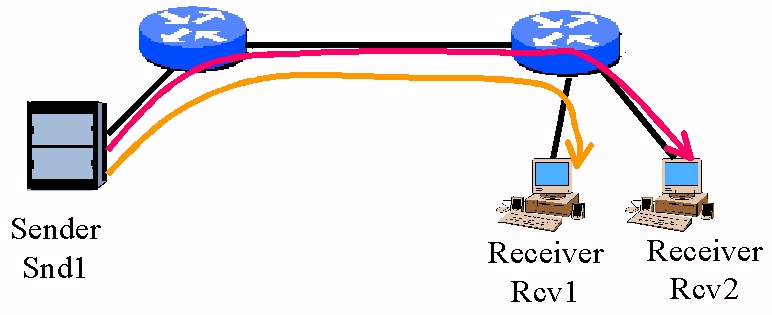
This paper evaluate the robustness of multicast routing and the performance
evaluation of multicast service using the experimental network. For
the performance evaluation of multucast service, we use the the DV (Digital
Video) transmission service, as the practical application for the
next generation Internet. The evaluatoin system uses the PIM (Protocol
Independent Multicast), that is an RPF (Reverse Path Forwarding) multicast
routing protocol. The packet loss observed at the end host is evaluated,
compared with the
case where the system provide the multicast service using N of the
multiple unicast packet transmission. We can make sure the
multicast system has better system scalability, regarding the number of
receivers, than the unicast based multicast system has. PIM operates
correctly and stably, even when the network has a routing loop. Finally,
we operate the DV multicast service over the nation-wide JB project IPv6
network using the PIM-SM, to make sure the correct operation.
1. Introduction
The most of the data communications over the currently operating Internet
is using the unicast data transmission with TCP or
UDP. And, many exisiting applications do transfer exactly the
same data to large number of receivers. Also, the upcomming
Internet applications will includes a realtime multicast services, such
as DV (Digital Video) program multicasting service or interactive multi-party
multimedia conferences or games. We have to establish a stable and
cost effective multicast data transmission infrastructure for the next
generation Internet applications.
With a multicast data transmission, when a sender
transfers a single packet toward the particular multicast group, the network
copies the packet to transfer them only to the particularreceivers belonging
to the corresponding multicast group. Since the sender does not need
to send the same data to every receivers, the network can provide an efficient
multicast data transmission services. With the multicast data
transmission, the required processing power at the sender and the required
bandwidth for the sender can be smaller than those with the unicast data
transmission. Since the total number of packtes transferred by the
network with multicast data transmission is smaller than that with unicast
data transmission, the possibility of inappropriate routing protocol operation
due to the large amount of user packet transmission with multicast data
transmission would be less than that with unicast data transmission. Also,
the diversity of the data reception time by the receivers must be smaller
that with the unicast data transmission, and the data reception delay by
the revievers must be smaller than that with the unicast transmission.
On the other hand, the multicast service may have
the following technical concernings.
2. Performance Evaluation of Packet Transmission
in Multicast Network
2.1 Evaluation System
Figures 1 and 2 show the evaluation system. Sender (Snd1) sends the packets to two receiver hosts (Rcv1 and Rcv2) through the routers (R1 and R2). Rcv1 and Rcv2 receive the same data from Snd1, i.e., multicating from Snd1 to Rcv1 and Rcv2. R1 and R2 are connected through the OC-3 ATM link, and the hosts (Snd1, Rcv1 and Rcv2) are connected to the routers through the 100MBase-T links.

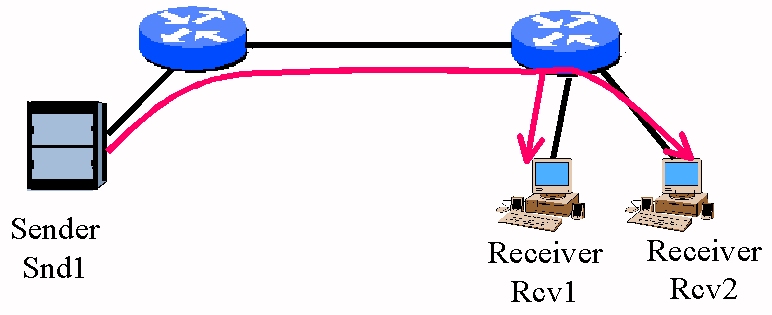
In the configuration of figure 1, Snd1 estblish two (unicast) packet
flows to each receiver host. This is the case where the multicast
service is provided by the multiple unicast connections. Routers (R1and
R2) do not need to copy the received data, and the sender
host (Snd1) copies the sending data. In the configuration of
figure 2, Snd1 establish one (multicast) packet flow to the receiver hosts.
This is the case where the multicast service is provided by a single multicast
connection. The router R2 copies the received data to deliver the data
to receivers (Rcv1 and Rcv2). Here, with the configuration of figure 2,
PIM-SM is applied to as the multicast routing. Sender host (Snd1)
can control the packet transmission rate to the network, with the rate
control (i.e., shaping).
All nodes, that are routers and hosts, are the ordinary
IBM compatible PC with the following specification.
Table 1 and figure 3 show the number of recieved packets and the number of dropped packets at the router (R1), parameterizing the packet transmission rate from the sender host (Snd1).
|
|
|
|
|
|
|
|
|
|
|
|
|
|
|
|
|
|
|
|
|
|
|
|
|
|
|
|
|
|

As shown, the router can not relay the unicast packets, in accordance with the increase of packet transmission rate from the sender with unicast based multicast. However, with the multiast service, the router can relay the packets and the packet dropped rate does not increase even when the packet transmissionrate from the sender host (Snd1) increases.
3. Evaluation of System Robustness of Multicast
Routing Protocol
3.1 Overview of RPF Multicast Routing
The RPF represents Reverse Path Forwarding. RPF is commonly used in the major multicast routing protocols, such as PIM that is used in the evaluation system discussed in this paper. In RPF system, the multiast packet transmission is executed using the unicast routing information. The multicast session is recognized and managed by the pair of sourece node IP address ("S") and IP multicast address assigned for the multucast group ("G"), i.e., {S,G}. When the router receives the multicast packet, the router checks the source IP address in it.
% Here,
% (1) the Recv_I/F : the interface
(including the virtual interface such as ATM or Frame Relay),
% where
receives the multicast.
% (2) Nxt_Hop_R_I/F : the interface,
where the packet to the source IP address shown in the received
multicast packet should relay based on the unicast routing information
3.2 Evaluation System
Figure 4 shows the evaluation system. Sender (Snd1) sends the
multicast packets toward two receiver hosts (Rcv1 and Rcv2) through the
routers (R1, R2 and R3). All routers run the PIM-SM multicast routing
protocol. All the data links in the system are 100MBase-T.
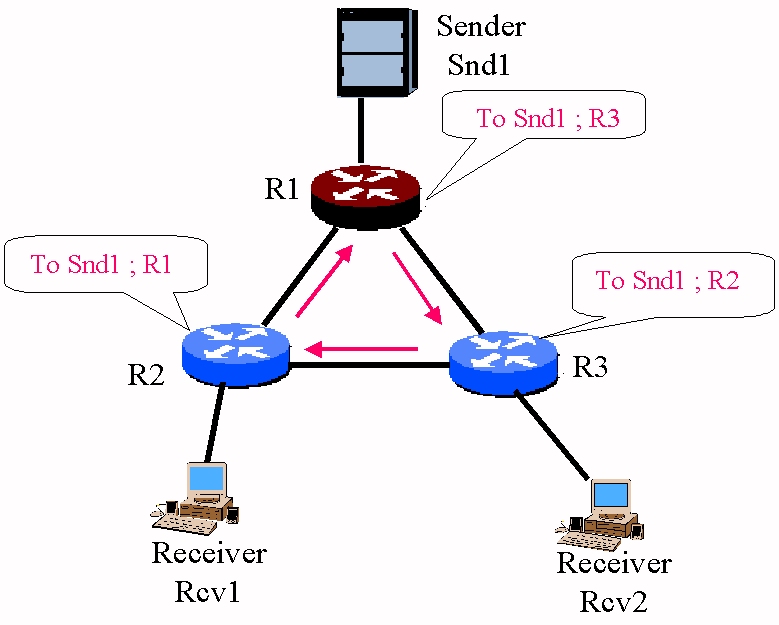
All nodes, that are routers and hosts, are the ordinary IBM compatible PC with the following specification.
3.3 Evaluation Results
The multicast packets are transferred to the
first hop router R1. R1 has to discard the all the received multicast
IP packet from the Snd1 node, since the interface receiving the IP multicast
packet is different from the interface RPF expected. We manually
modify the routing information at R1, so that the evaluation system has
a routing loop among R1, R2, and R3. By the applicatin of the RPF
mechanism, it is expected that the R1 silently drop the multicast packets.
The experimental system actually discard the IP
multicast packets at the R1, when the R1 has the wrong unicast routing
information to form a routing loop. When we use the multiple unicast
connection to provide the multicast service from Snd1 to Recv1 and Rcv2,
the unicast packets do loop among the R1, R2 and R3. Moreover, the
packet to be looped shall be two packet flows (both toward Recv1 and toward
Rcv2). We did make sure the routing loop has generate the congestion
with unicast based multicast service. And, also, we did make sure
the avoid of packet transmission at the entry router of the (unicast) routing
loop, to avoid the network congestion due to the unicast routing loop.
4. Digital Video Transmission over the Nation-wide
JB Project Network
4.1 Network Configuration
We evaluate our developped multicast system over
the nation-wide JB project network. The JB network [1] is the jointly
operated among WIDE project [2], CKP[3]
and ITRC[4]. Most of the high
speed links are provided by the JGN
(Japan Gigabit Network) operated by TAO[5], by the TTNet
[6] and by the CRL[7]. It
uses IPv6 as the basic internet protocol. Figure 5 shows the network
configuration of the JB network, regarding only the high speed links.
More than ten organizations are interconnected by the high speed datalinks
(e.g., OC-12 ATM, Gigabit Ethernet). All organizations are
interconnected thtough the PC-based routers with KAME IPv6 protocol stack,
and run the PIM-SM for multicast service. We had two RP (Rendezvous
Point) routers in the network, to create shared multicast trees.
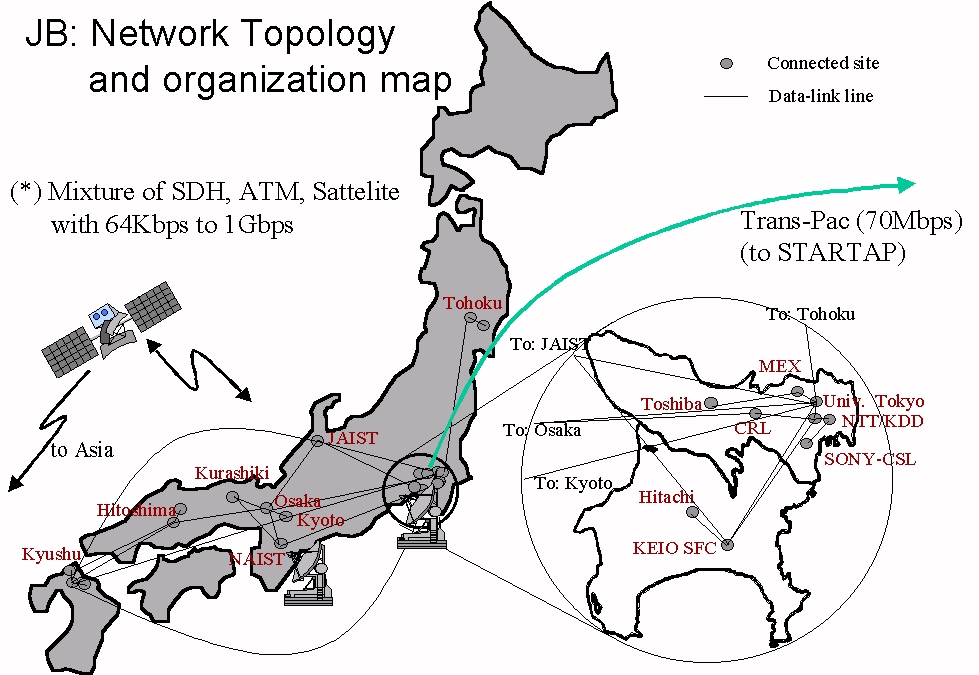
4.2 Experiment of DV Multicast Service over the JB
Project Network
Figure 6 shows the verview of DV multicast service
over the JB project IPv6 network. The technical workshop held by
the WIDE project is multicasted to more than ten sites over the nation-wide
JB project network, using the DV video stream. The DV stream is multicasted
to the sites using the PIM-SM with IPv6. Each site observes the same
DV image, simultaneously. And, when the participants from the remore
site can interactively join to the workshop using the networ. This
means that the remote site can send the DV stream, whenever they have a
question. The DV stream from the remote site also multicasted
to all the participating sites to the multicast service, through the RP
routers. The experimantal interactive milticast session for one-day
workshop using the DV multicasting has been correctly operated using the
PIM-SM.
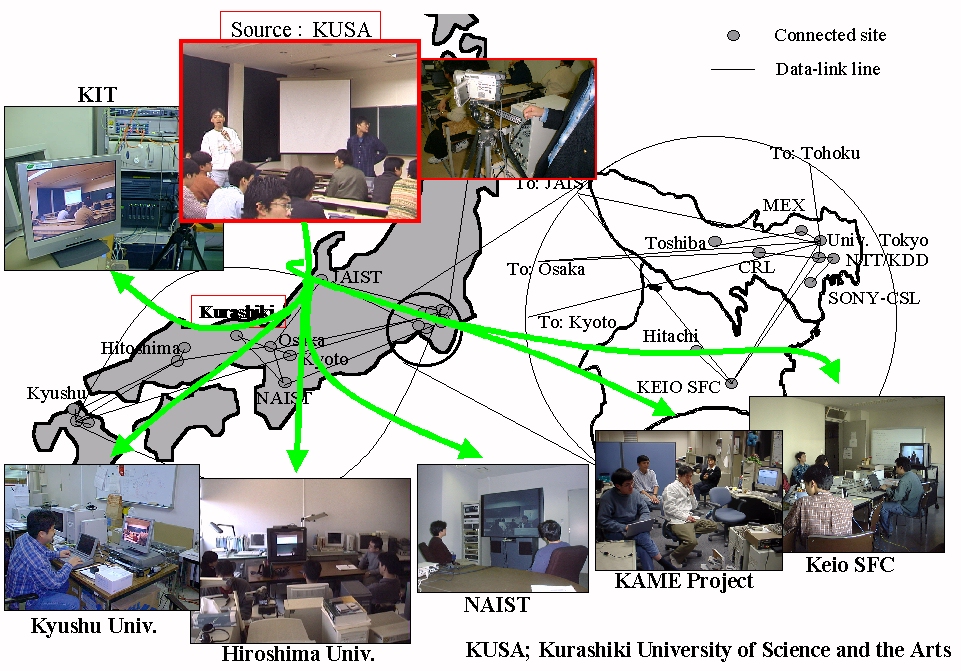
5.Conclusion
This paper evaluate the robustness of multicast
routing and the performance evaluation of multicast service using the experimental
network. For the performance evaluation of multucast service, we
use the the DV (Digital Video) transmission service, as the practical
application for the next generation Internet. The evaluatoin system
uses the PIM (Protocol Independent Multicast), that is an RPF (Reverse
Path Forwarding) multicast routing protocol. The packet loss observed
at the end host is evaluated, compared with the
case where the system provide the multicast service using N of the
multiple unicast packet transmission. We can make sure the
multicast system has better system scalability, regarding the number of
receivers, than the unicast based multicast system has. PIM operates
correctly and stably, even when the network has a routing loop. Finally,
we operate the DV multicast service over the nation-wide JB project IPv6
network using the PIM-SM, to make sure the correct operation.
The following items would be further study items.